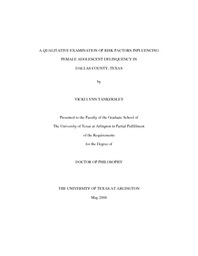
ATTENTION: The works hosted here are being migrated to a new repository that will consolidate resources, improve discoverability, and better show UTA's research impact on the global community. We will update authors as the migration progresses. Please see MavMatrix for more information.
Show simple item record
| dc.contributor.author | Tankersley, Vicki Lynn | en_US |
| dc.date.accessioned | 2007-08-23T01:55:54Z | |
| dc.date.available | 2007-08-23T01:55:54Z | |
| dc.date.issued | 2007-08-23T01:55:54Z | |
| dc.date.submitted | April 2006 | en_US |
| dc.identifier.other | DISS-1257 | en_US |
| dc.identifier.uri | http://hdl.handle.net/10106/25 | |
| dc.description.abstract | The purpose of this study was to identify the risk factors influencing juvenile delinquency for females in Dallas County, Texas and discuss the implications of the findings for future practice, policy, and research. Qualitative research methods in this study have given a voice to female adolescents housed in the Dallas County Juvenile Detention Center by giving these young women the opportunity to share and convey information about their lives and factors they felt had been influential in their referral to the Dallas County Juvenile Probation Department.
The sample included twenty-six female adolescents who were housed at the Dallas County Juvenile Detention Center between April 2005 and May 2005. Each respondent was between twelve and seventeen years old and currently facing at least one petition of delinquency or violation of her probation. Each youth agreed to participate in a face-to-face interview that was audio-recorded. The phenomenological approach to qualitative data analysis was utilized and the process of data scrutiny involved the search and organization of statements regarding the ways respondents experienced factors and events in their daily lives.
Results showed that most young women had been referred to the juvenile department for a non-serious and non-violent offense; there were a disproportionate number of minority female youth detained compared to the county's population; and the majority of youth had previously been referred to the juvenile department. In addition, the majority of youth reported a good relationship with at least one adult in their home; over half described enjoying portions of their educational experiences; the youth came from a wide variety of neighborhoods; and very few youth reported previous incidents of abuse or neglect. Yet, the majority of youth reported previously engaging in high-risk behaviors including: use and experimentation with substances, association with negative peer groups, and poor decision making skills. Overall, the majority of youth viewed themselves in a positive light but indicated they lacked the appropriate coping, decision making and problem solving skills to adequately cope with the variety of stressors encountered in their family units, friendships, neighborhoods, communities, and schools. | en_US |
| dc.description.sponsorship | Rycraft, Joan | en_US |
| dc.language.iso | EN | en_US |
| dc.publisher | Social Work | en_US |
| dc.title | A Qualitative Examination Of Risk Factors Influencing Female Adolescent Delinquency In Dallas County, Texas | en_US |
| dc.type | Ph.D. | en_US |
| dc.contributor.committeeChair | Rycraft, Joan | en_US |
| dc.degree.department | Social Work | en_US |
| dc.degree.discipline | Social Work | en_US |
| dc.degree.grantor | University of Texas at Arlington | en_US |
| dc.degree.level | doctoral | en_US |
| dc.degree.name | Ph.D. | en_US |
| dc.identifier.externalLink | https://www.uta.edu/ra/real/editprofile.php?onlyview=1&pid=619 | |
| dc.identifier.externalLink | https://www.uta.edu/ra/real/editprofile.php?onlyview=1&pid=619 | |
| dc.identifier.externalLinkDescription | Link to Research Profiles | |
Files in this item
- Name:
- umi-uta-1257.pdf
- Size:
- 1.992Mb
- Format:
- PDF
This item appears in the following Collection(s)
Show simple item record


